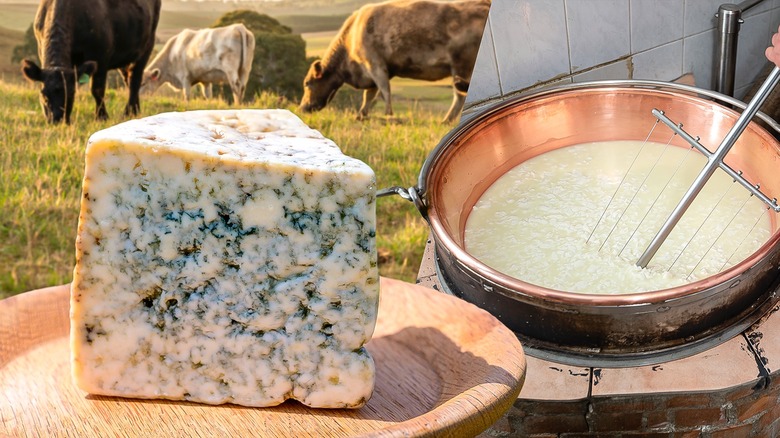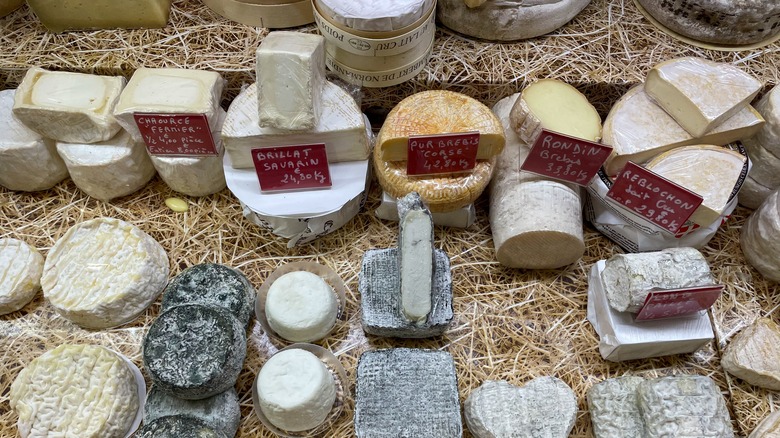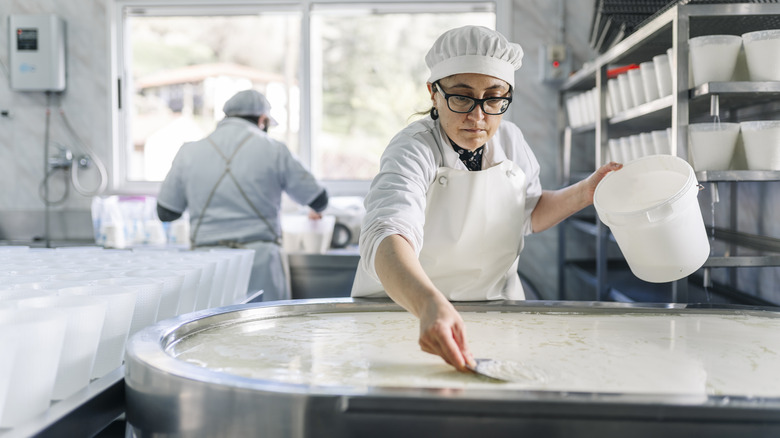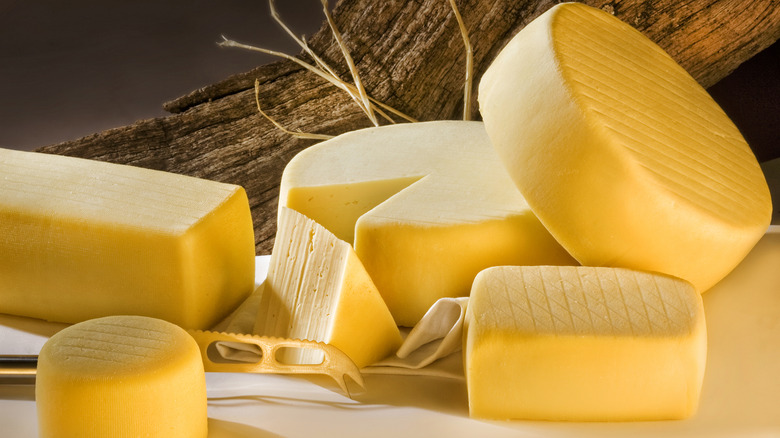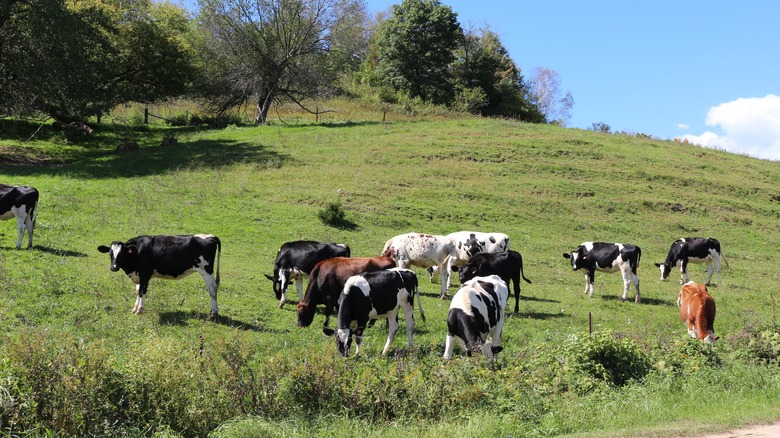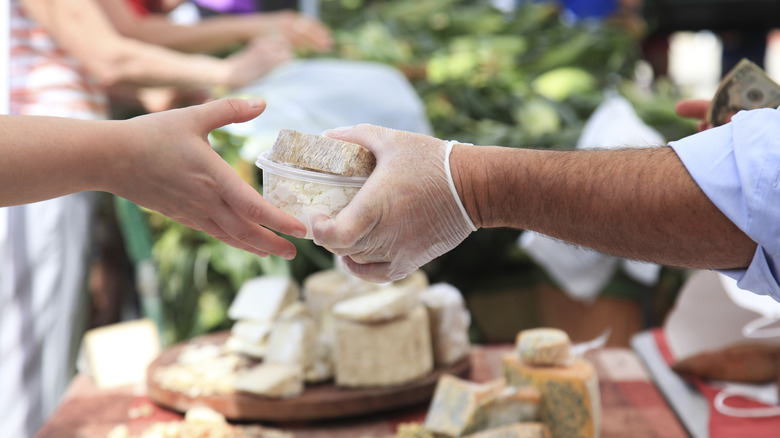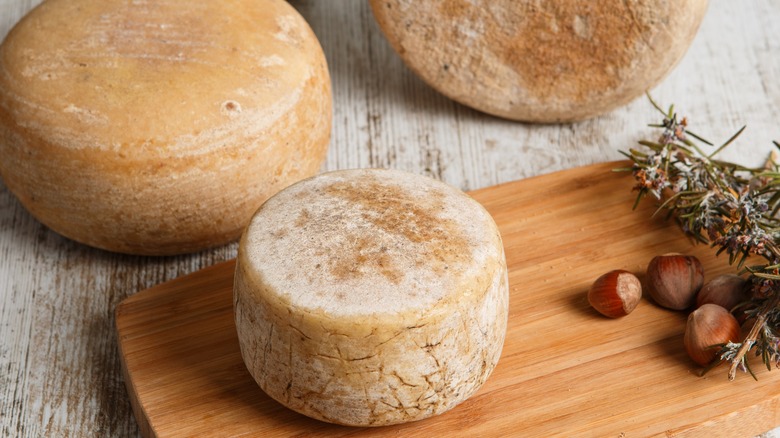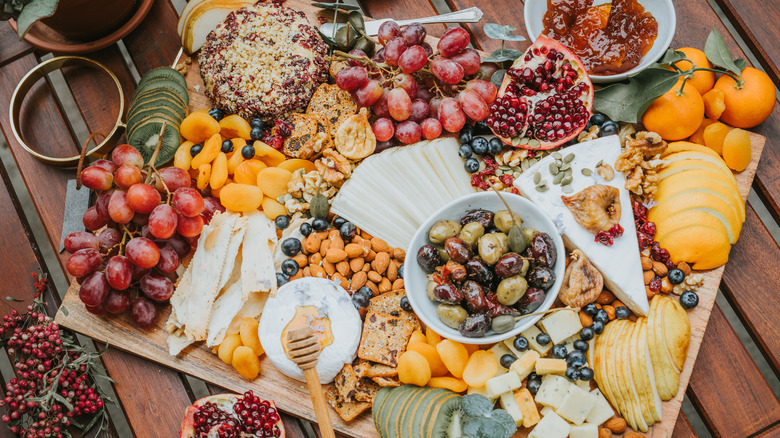A Beginner's Guide To Artisanal Cheese
Cheese, glorious cheese. If you're a cheese lover, there's no shortage of options to satisfy your cheese tooth. From Swiss to cheddar to Parmesan, and the hundreds of varieties in between, there's a type of cheese to suit every palate. There are 600 varieties of cheese produced in the U.S. alone and cheese is the largest specialty market in the country. It's no surprise that cheese consumption has reached record levels in recent years. In 2022, the average American consumed more than 40 pounds of cheese.
Most of the cheese sold in grocery stores is mass-produced in factories, but artisanal cheeses, like hoop cheese, cupola, and formai de mut have been gaining popularity in recent years. When the artisan cheese movement began in the '70s, there were only about 48 artisan cheesemakers in the U.S. In 2019, there were more than 1,000.
Artisanal cheese offers a world of rich flavors and textures, crafted with care and tradition that mass-produced cheeses simply can't replicate. We've reached out to artisanal cheese experts Jill Erber, owner of Cheesetique, an old-school cheese shop and cheese-focused restaurant in Alexandria, Virginia; food educator and certified cheese professional Kyra James, owner of Own Your Funk; and Kara McGrath, owner of Paste & Rind cheese shop in Washington, D.C. They're sharing what you need to know about these specialty cheeses, whether you're a curious beginner or a cheese enthusiast.
What is artisanal cheese?
Artisanal cheese is handcrafted in small batches using traditional methods and high-quality, ingredients. Unlike many mass-produced cheeses, which rely on industrial processes and additives, artisanal cheese is made with simple ingredients like milk, salt, and rennet. The result is unique flavors and textures reflecting the cheesemaker's craftsmanship. But there's more to this type of cheese than its great taste.
"Artisanal cheese isn't just about flavor, which is almost always superior to mass-produced cheeses," says Jill Erber. "It's about understanding where your food comes from and who makes it." You can purchase it with the knowledge that you're supporting real craftspeople. "Artisanal by definition means made in a traditional or non-mechanized way, so in supporting/purchasing these cheeses, consumers can automatically know they are supporting human beings, animals, and the land used to create them," says Kyra James.
Kara McGrath believes cheese lovers should look for artisanal cheese for the same reasons they seek out craft beer: "better ingredients, unique flavors, and producers that really care about their product." McGrath notes, "Aside from tasting way better, artisanal cheese is also far more impactful on local economies and more environmentally friendly."
If you have trouble discerning if a cheese is, in fact, artisanal, McGrath recommends checking the label. "Key things to look for are the phrases 'farmstead' and 'handmade,' badges indicating award recognitions, and contact information and addresses on labels. Factories aren't putting their phone numbers on their cheeses," she says.
The birth of the artisanal cheese movement
The artisanal cheese movement emerged after World War II when industrialized, processed foods gained popularity and convenience was king. Efficiency and mass manufacturing brought about processed cheeses with standardized flavors and long shelf lives. However, by the 1970s and 1980s, after the country's mid-century processed food boom, a growing number of cheesemakers sought to revive traditional, small-batch production methods that emphasized quality, craftsmanship, and natural ingredients over industrialized convenience.
The back-to-the-land movement inspired consumers to seek out foods made locally with local ingredients and traditional techniques like those used in Europe. Artisanal cheese fit the bill. "Consumers know that artisanal cheese is made carefully by hand, with attention to animal care, environmental sustainability, and product quality," says Jill Erber. "Cheese lovers can feel good about supporting these efforts while enjoying something delicious."
The first artisanal cheesemakers in the United States were women like Laura Chenel, who made artisanal goat's milk cheese in California, and Allison Hooper, who brought the cheese-making expertise she gained while studying abroad in France back to the U.S. to start the Vermont Creamery. Women were at the forefront of the artisanal cheese movement and continue to be leaders in the industry. In 2006, half of the country's artisanal cheese companies were women-led.
Artisanal cheese vs. processed cheese
All cheese is not created equally. While artisanal cheese makers tend to go the extra mile to hand-make cheese that tastes great, most processed cheese is machine-made, with shelf life and uniformity as top priorities.
"Mass-produced cheese makers tend to prioritize consistency and perceived safety, so they often use lab-produced ingredients and extreme pasteurization to create the same cheese every time," says Jill Erber.
Taste also sets artisanal cheese apart. "Think about a child learning to play piano where they can only play a simple melody. That's mass-produced cheese: one note and very simple," says Kara McGrath. "Now think about a professional concert pianist who plays a melody, countermelody, harmony, and chords all at once. That's artisanal cheese: deep, complex, and nuanced."
While processed cheese makers work to avoid variability in their products, artisanal producers, on the other hand, embrace the natural variations that may occur without the additives and processing. According to Kyra James, "Artisanal cheeses lack preservatives and oils and focus on the animal's milk; with seasonality and their diet playing a huge role, the flavor of a winter cheddar will taste much different from a summer artisan cheddar."
Another key difference can be found in the ingredients used to make the cheese. You won't find artificial ingredients or flavors in artisanal cheese. Additives like emulsifiers, which affect texture, and extenders, which prevent mold from developing don't make the cut. Instead, artisanal cheese makers focus on natural ingredients.
Where is artisanal cheese made?
Artisanal cheese is made around the world typically on small farms or in specialty dairies where cheese makers have access to high-quality, local milk. In the United States, there are more than 1,000 licensed artisanal cheese producers. These cheese makers are scattered across 43 states, but California, Vermont, and Wisconsin, where the cheese capital of the world is located, are where most can be found.
It's no surprise that California and Wisconsin top the list of artisanal cheese makers. They're the top two milk-producing states in the country, and quality milk is a requirement for producing quality cheese. The milk used to make these cheeses plays a significant role in the flavor and texture of the cheese. Artisanal cheese production is heavily influenced by the terroir or the geography of the location where it's made. Everything from the humidity and climate of the region, the makeup of the grass the cows graze on, and the bacteria present in the soil can affect the flavor of the milk and, ultimately, the cheese it's made with. Cheese made using the same techniques will likely taste different if produced in another region.
Vermont is also known for producing excellent cheese. The state boasts more than 45 cheesemakers that produce more than 150 types of cheese, many of those artisanal. Other states with artisanal cheesemakers include Alaska, Hawaii, and Oregon.
Where to buy artisanal cheese
Artisanal cheese can be found at a variety of specialty retailers that prioritize quality and craftsmanship. You can find specialty cheeses in traditional grocery stores, but local cheese shops will likely offer a better selection. Kara McGrath recommends looking at your local cheesemonger as you would a sommelier in a restaurant. "This person knows a ton about artisanal cheese and can help you find the perfect product for your needs, and may even let you taste some," she explains.
"The best place to buy artisanal cheese depends on where you live," explained cheese expert Kyra James. She recommends that shoppers research and support local vendors when they shop for artisanal cheese. "With a bit more research, consumers can often buy artisanal cheese directly from the cheesemaker," she said. This allows you to discover regional varieties and seasonal offerings while simultaneously supporting small businesses.
Online shopping makes it easy for cheese lovers to sample artisanal cheese from producers all over the world. Cheesemakers like Saxelby Cheese sell their collection of farmstead cheese on their website and Heritage Foods, a mail-order and wholesale company, runs an Artisan Cheese Series where it features a bundle of artisanal cheeses every few weeks.
Wherever you buy your cheese, you should "have your cheese cut to order instead of choosing pre-wrapped pieces," according to Jill Erber. "Cheese is alive, and suffocating plastic wrap is the enemy to a healthy cheese."
Nutritional value of artisanal cheese
Artisanal cheeses are a rich source of essential nutrients and often contain higher nutritional value than processed varieties of cheese. Velveeta, which was made from real cheese when it was first created, now consists mostly of whey protein concentrate, milk protein concentrate, and a slew of additives. Artisanal cheeses, on the other hand, are a reflection of the vitamins and nutrients in the milk used to make it. They're a good source of valuable nutrients like vitamins, D, K2, and calcium. The fermentation process artisanal cheese undergoes also includes good-for-you bacteria called probiotics, which support digestion and gut health.
If you're looking to add high-quality protein to your diet, start snacking on artisanal cheese. They're full of complete proteins that contain all nine of the essential amino acids our bodies need, but can't produce naturally. You can enjoy the fantastic flavors artisanal cheese offers and nourish your body.
How to serve artisanal cheese
Artisanal cheese can be served and used in the same ways as regular cheese. They can add their exceptional flavor to everything from cheese boards and salads, to sandwiches and as an ingredient in your favorite cheesy recipes.
Serving artisanal cheese is an opportunity to highlight its unique flavors and textures. To get the most flavor from your cheese, artisanal or not, it should be removed from the fridge about an hour before serving and allowed to come to room temperature first. Cold cheese changes the cheese's texture, making it firm and stiff. The closer the cheese is to our body temperature, the easier it is to taste every flavorful nuance. There's science to support this. The fat in cheese contains a lot of flavor. When the cheese is cold, the fat molecules constrict, making it difficult for them to release their flavor. At room temperature, between 68 and 72 degrees Fahrenheit, the molecules expand, unleashing their infinite flavors.
If you're pairing your artisanal cheese with wine, consider selecting wine and cheese that are grown in the same region. The same terroir that affects your cheese's flavor will also impart specific flavors to your wine.
